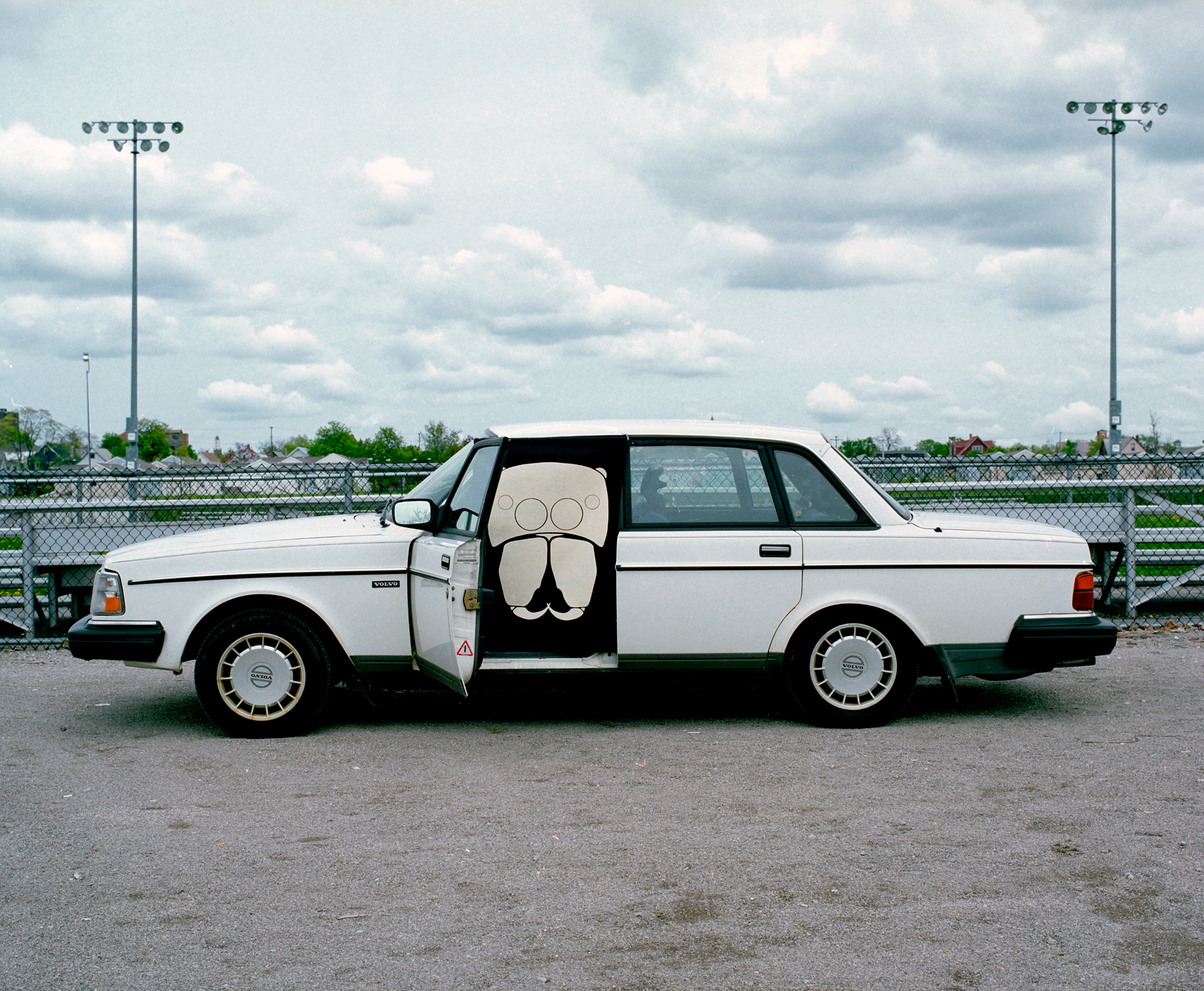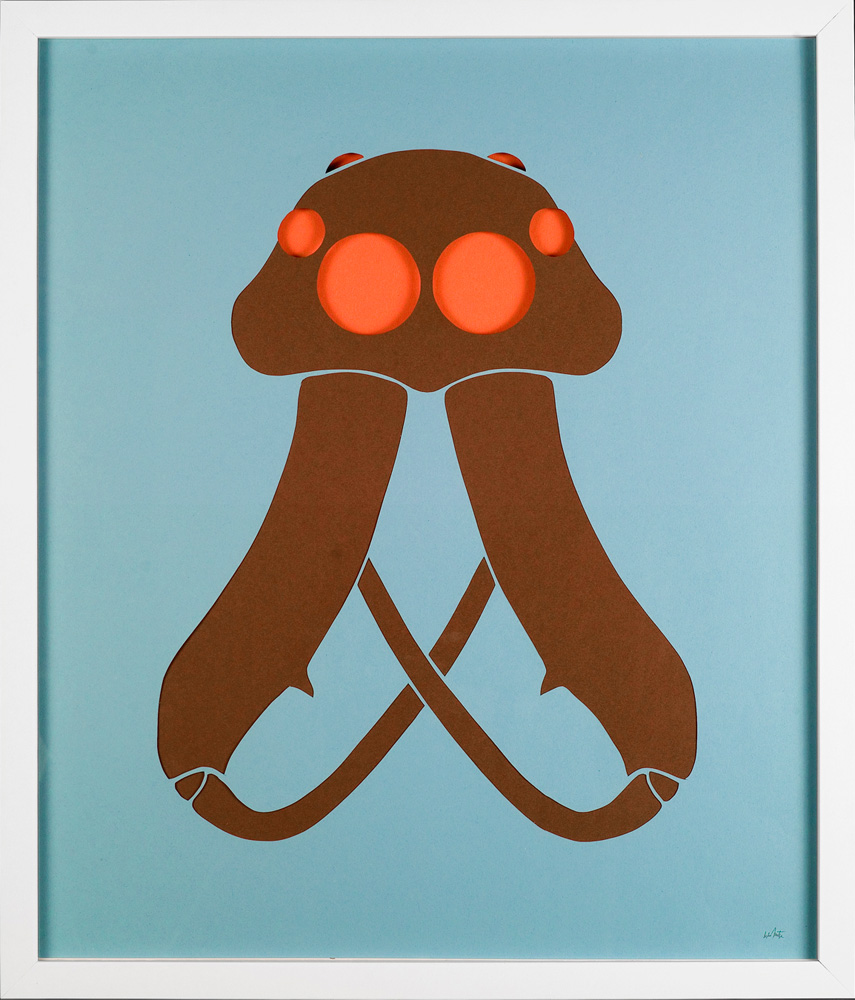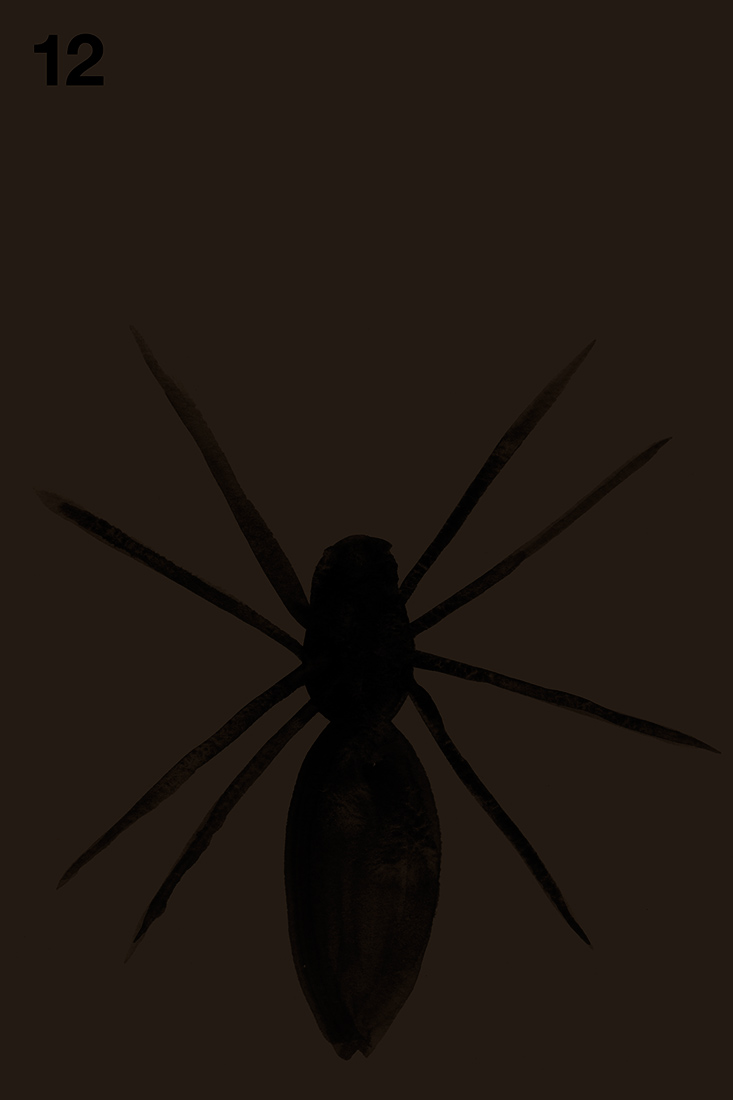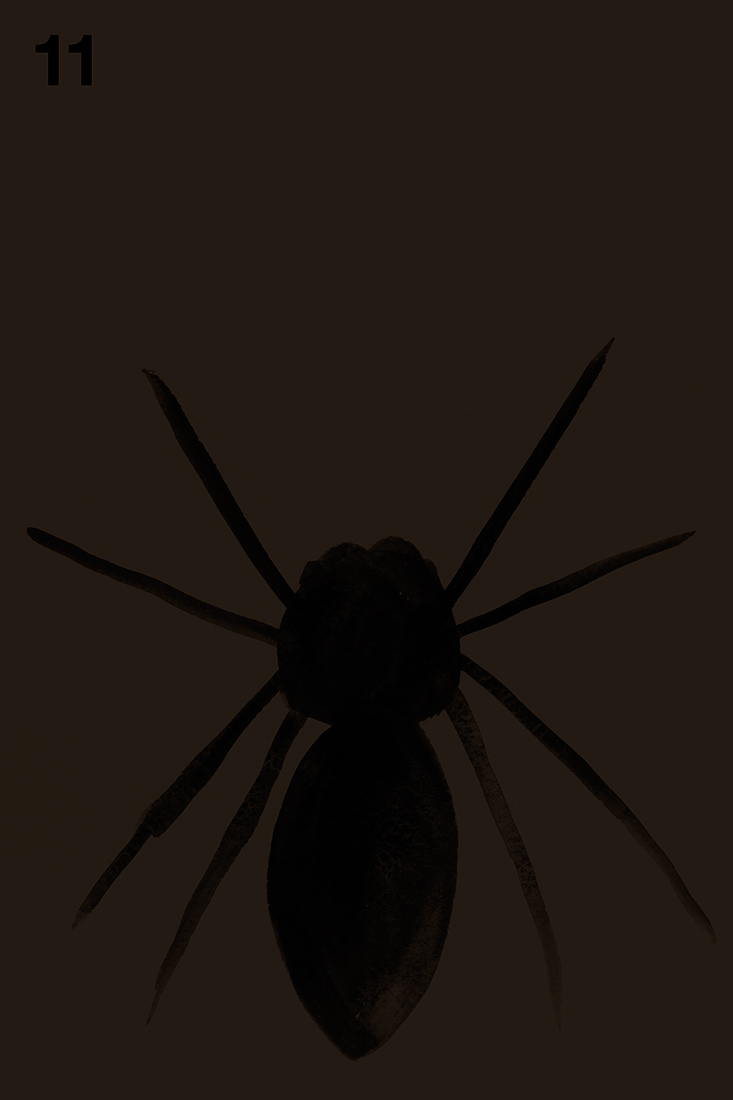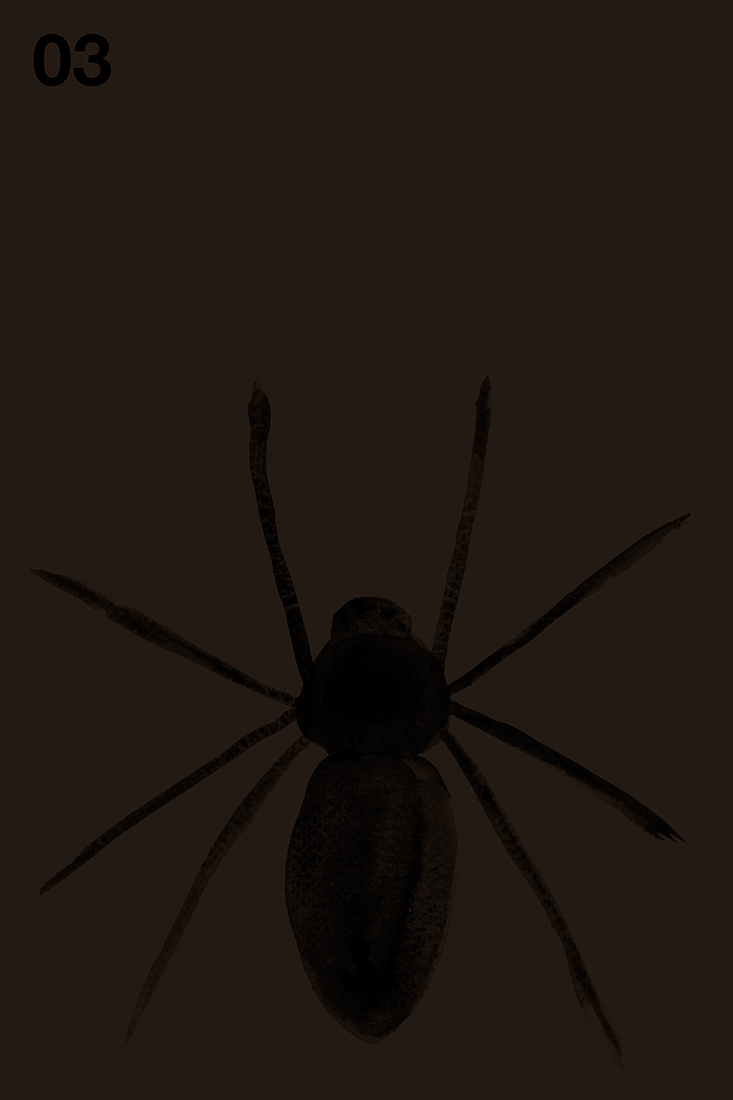Secondary Occupants / Animals & Architecture
Secondary Occupants Animals & Architecture is an ongoing series of projects that consider the animal/architecture relationship in a common conceptual space. At the center of that space is an unnamed fictional investigator who is the lens through which the work is made. The aims and motivations of this author are not entirely clear. However, clues to the logic behind his thinking can be found in elements of the project, particularly his reading materials (see Section 5).
The first phase of this project was called To Know The Spiders. The title was adapted from B. J. Kasten’s 1978 arachnology manual “How to Know the Spiders.” The project was a visual exploration of the spiders that live inside and on the exterior of buildings. The process began with the collecting and killing of a spider. I assigned the specimen a number and stored it in a glass vial. I then studied its face under a microscope and from the resulting drawings created a portrait of the spider in the form of a fabric banner. I then photographed the banner in the exact spot of collection. The banner illuminated the presence of a silent witness and sometime symbiotic partner while also serving as an ironic memorial to the spider that had to die for that understanding to be gained. The banners depict the faces of spiders reduced to their most basic shapes, the head, eyes, jaws and fangs. The photographs of the banners show them hanging in very mundane domestic settings, bedrooms, kitchens, and garages. Set against the familiar materials of every day life, the banner image appears as an alien presence. (see Section 2)
I chose to depict the face of the spider because the face is not the way we normally engage with the animal. With many of the higher life-forms the face is the natural point of visual contact, but with invertebrates, and spiders in particular, identity
collapses upon viewing the face. With its six to eight eyes and complicated mouthparts, the face of the spider resists our natural inclination to anthropomorphize. Their faces, from our evolutionarily distant vantage point hardly seem to be faces at all. There is a sense in which I want to evoke the notion that they are old and we are new. Their ancient snares and stratagems function as they have for millions of years; our time lines overlap in the corners of every human dwelling. At this juncture our habits are aligned. In fact, our lives overlap to an astonishing degree, spiders or at least traces of them, such as decaying webs and drag-lines, are absolutely everywhere. There is without a doubt a spider or its materials in the room in which you are reading this.
After spending time observing and collecting spiders from occupied buildings I became interested in the role that spiders and other animals have in processes of decay in abandoned buildings. While the structural degradation of a building can be caused directly by animals (carpenter ants, squirrels, rats, wood boring beetles, etc.), there is also a conceptual transformation that takes place. The decay process in an unoccupied house is one that physically and conceptually transforms interior spaces into exterior ones. In an inhabited home, the presence of these animals are a threat to the social and psychological frameworks that buttress us safely on the “inside.” In an abandoned house, the threat is carried out, and the conceptual structures of human domestic space are dismantled (see Sections 4 below).
You will find further images and descriptions of the project below.
1. Specimen Portrait Banners
The portrait banners are simplified representations of animals that I have collected or observed. All of the banners depicting spiders (originally part of the To Know the Spiders project), are based on drawings I made while looking at collected specimens through a microscope. The non-spider portraits (see section 7 and 8) are based on observation and other source materials. All banners measure 39 x 27 inches / 99 x 69 cm, and are made from canvas duck cloth and felt. Wooden dowels are inserted through the looped fabric at both ends.
To Know the Spiders, Black & White Gallery, New York, 2008
2. Banner Photographs
This series was at the center of the first phase of Secondary Occupants called To Know the Spiders. The process began with the collection and killing of a spider. The specimen was assigned a number and stored in a glass vial. I then studied its face under a microscope and from the resulting drawings created a portrait of the spider in the form of a fabric banner. The banner was then placed and photographed in the exact spot of collection.
3. Specimen Vial Photographs
These photographs represent a sampling of the specimens collected in the process of creating To Know the Spiders (section 1 & 2). 2008, Digital pigment print, 19 x 44 inches / 48 x 112 cm.
4. Abandoned House/Decay Community
After spending time observing and collecting spiders in occupied buildings I became interested in the role that spiders and other animals have in processes of decay in abandoned buildings. While the structural degradation of a building can be caused directly by animals, (carpenter ants, squirrels, rats, wood boring beetles, etc.) there is also a conceptual transformation that takes place. The decay process in an unoccupied house is a process that physically and conceptually transforms interior spaces into exterior ones. In an inhabited home, the presence of these animals are a threat to the social and psychological frameworks that buttress us safely on the “inside.” In an abandoned house, the threat is carried out, and the conceptual structures of human domestic space are dismantled. To represent this process I constructed an installation that expanded on the banners of To Know the Spiders. The centerpiece of the installation is the Abandoned House/Specimen Map Table, which depicts the floor plan of a typical American early 20th century single family home. Graphics on the plan locate the areas where various animals were found. Lines from the occupied places run to the edge of the table where they continue as threads ascending to the ceiling, fabric portrait banners that depict the spiders, insects, birds and mammals associated with the occupied space hang from the ends of these threads. I did not base the installation on an actual house but on a composite of my own observations. The lines on the Specimen Map Table present an almost impossible to follow set of connections. The seemingly meticulous mapping serves to reinforce the feeling of multiple levels of activity.
5. Volumes from an Imagined Intellectual History of Animals, Architecture & Man (2010–2014)
This series of faux books, records and posters are meant to be the reading, listening and viewing materials of the fictional investigator at the center of the project. The items all connect in some way to the intersection of animals and architecture (often rather obliquely). I have designed new covers for old library books, mostly using a mid-twentieth century modernist graphic design style. As physical objects they are fairly convincing fakes. The invented volumes walk the line between absurdity and plausibility. The books appear to lend intellectual support to the efforts of the investigator, or at least clues to his thinking. I include them in exhibits as a way to introduce certain themes and relationships into the mind of the viewer which they then take to the other elements of the project. With the exception of one found photograph (Invertebrates & Architecture), all of the photographs, graphics, logos and text were generated by the artist.
See the whole series on the faux books page.
6. Research Assemblage
Photographs taken in the course of researching the Secondary Occupants project. There is not a fixed number of images , printing methods or arrangement. The Assemblage is different each time it is installed. The images are pinned to the wall using nickel plated steel t-pins.
7. Studies
A series of paper cuts, prints, and collages connecting to the themes of the project.
In Ruins (2014–Present)
This is an on going series of macro photographs of abandoned spider webs. The work identifies the non-human ruins and landscapes that exist all around us in the peripheral spaces of our buildings. Info: 2014, 16 x 20 inches, digital pigment prints.
9. Spider Paintings
These pieces are a series of small (10 x 8 inches) watercolors depicting spiders that I painted, scanned, added a dark overlay of color and printed as one of a kind prints. Info: 2014, 36 x 24 inches, digital pigment print.
10. Secondary Occupants Mural
In 2013 I was commissioned by restaurateur Mark Goldman to create a mural on the side of Allen Street Hardware, a restaurant and bar. I adapted the illustration from the cover of Secondary Occupants (section 5). The mural is part of a street art initiative started by Goldman in the Allentown district of Buffalo, New York.







